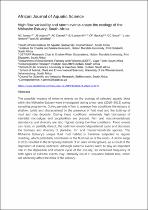 ResearchSpace
ResearchSpace
High flow variability and storm events shape the ecology of the Mbhashe Estuary, South Africa
JavaScript is disabled for your browser. Some features of this site may not work without it.
- ResearchSpace
- →
- Research Publications/Outputs
- →
- Journal Articles
- →
- View Item
| dc.contributor.author |
James, NC

|
|
| dc.contributor.author |
Adams, JB

|
|
| dc.contributor.author |
Connell, AD

|
|
| dc.contributor.author |
Lamberth, SJ

|
|
| dc.contributor.author |
MacKay, CF

|
|
| dc.contributor.author |
Snow, GC

|
|
| dc.contributor.author |
Van Niekerk, Lara

|
|
| dc.contributor.author |
Whitfield, AK

|
|
| dc.date.accessioned | 2020-10-27T12:40:10Z | |
| dc.date.available | 2020-10-27T12:40:10Z | |
| dc.date.issued | 2020-03 | |
| dc.identifier.citation | James, N.C., Adams, J.B., Connell, A.D., et al. High flow variability and storm events shape the ecology of the Mbhashe Estuary, South Africa. African Journal of Aquatic Science, vol, 45(1). pp. 131-151 | en_US |
| dc.identifier.issn | 1608-5914 | |
| dc.identifier.issn | 1727-9364 | |
| dc.identifier.uri | https://doi.org/10.2989/16085914.2020.1733472 | |
| dc.identifier.uri | https://www.tandfonline.com/doi/abs/10.2989/16085914.2020.1733472 | |
| dc.identifier.uri | http://hdl.handle.net/10204/11644 | |
| dc.description | Copyright: 2020, Taylor & Francis Group. Due to copyright restrictions, the attached PDF file contains the abstract of the full-text item. For access to the full-text item, please consult the publisher's website. | en_US |
| dc.description.abstract | The possible impacts of extreme events on the ecology of selected aquatic biota within the Mbhashe Estuary were investigated during a four year (2010–2013) spring sampling programme. During periods of low to average flow conditions the estuary is shallow, turbid and characterised by the presence of fluid mud and the build-up of mud and clay deposits. During these conditions, extremely high biomasses of intertidal microalgae and zooplankton are present. Fish and macroinvertebrate abundance and diversity are also highest during low-flow conditions. Flood events can reset, or partially disrupt, the sediment erosion/depositional cycle and decrease the biomass and diversity of plankton, fish and macroinvertebrate species. The Mbhashe Estuary’s unique fluid mud habitat is therefore subjected to regular resetting, which potentially contributes to the fluid nature of the muds. A storm surge in 2011 resulted in the temporary dieback of an area of mangroves, as a result of the deposition of marine sediment. Although extreme events seem to play an important role in the deposition and erosion cycle of the estuary, an increased frequency of both types of extreme events may ultimately result in estuarine habitat loss, which will adversely affect the biota of the estuary. | en_US |
| dc.language.iso | en | en_US |
| dc.publisher | Taylor & Frances | en_US |
| dc.relation.ispartofseries | Workflow;23818 | |
| dc.subject | Climate change | en_US |
| dc.subject | Fish | en_US |
| dc.subject | Floods | en_US |
| dc.subject | Macroinvertebrates | en_US |
| dc.subject | Mangroves | en_US |
| dc.subject | Phytoplankton | en_US |
| dc.title | High flow variability and storm events shape the ecology of the Mbhashe Estuary, South Africa | en_US |
| dc.type | Article | en_US |
| dc.identifier.apacitation | James, N., Adams, J., Connell, A., Lamberth, S., MacKay, C., Snow, G., ... Whitfield, A. (2020). High flow variability and storm events shape the ecology of the Mbhashe Estuary, South Africa. http://hdl.handle.net/10204/11644 | en_ZA |
| dc.identifier.chicagocitation | James, NC, JB Adams, AD Connell, SJ Lamberth, CF MacKay, GC Snow, Lara Van Niekerk, and AK Whitfield "High flow variability and storm events shape the ecology of the Mbhashe Estuary, South Africa." (2020) http://hdl.handle.net/10204/11644 | en_ZA |
| dc.identifier.vancouvercitation | James N, Adams J, Connell A, Lamberth S, MacKay C, Snow G, et al. High flow variability and storm events shape the ecology of the Mbhashe Estuary, South Africa. 2020; http://hdl.handle.net/10204/11644. | en_ZA |
| dc.identifier.ris | TY - Article AU - James, NC AU - Adams, JB AU - Connell, AD AU - Lamberth, SJ AU - MacKay, CF AU - Snow, GC AU - Van Niekerk, Lara AU - Whitfield, AK AB - The possible impacts of extreme events on the ecology of selected aquatic biota within the Mbhashe Estuary were investigated during a four year (2010–2013) spring sampling programme. During periods of low to average flow conditions the estuary is shallow, turbid and characterised by the presence of fluid mud and the build-up of mud and clay deposits. During these conditions, extremely high biomasses of intertidal microalgae and zooplankton are present. Fish and macroinvertebrate abundance and diversity are also highest during low-flow conditions. Flood events can reset, or partially disrupt, the sediment erosion/depositional cycle and decrease the biomass and diversity of plankton, fish and macroinvertebrate species. The Mbhashe Estuary’s unique fluid mud habitat is therefore subjected to regular resetting, which potentially contributes to the fluid nature of the muds. A storm surge in 2011 resulted in the temporary dieback of an area of mangroves, as a result of the deposition of marine sediment. Although extreme events seem to play an important role in the deposition and erosion cycle of the estuary, an increased frequency of both types of extreme events may ultimately result in estuarine habitat loss, which will adversely affect the biota of the estuary. DA - 2020-03 DB - ResearchSpace DP - CSIR KW - Climate change KW - Fish KW - Floods KW - Macroinvertebrates KW - Mangroves KW - Phytoplankton LK - https://researchspace.csir.co.za PY - 2020 SM - 1608-5914 SM - 1727-9364 T1 - High flow variability and storm events shape the ecology of the Mbhashe Estuary, South Africa TI - High flow variability and storm events shape the ecology of the Mbhashe Estuary, South Africa UR - http://hdl.handle.net/10204/11644 ER - | en_ZA |





